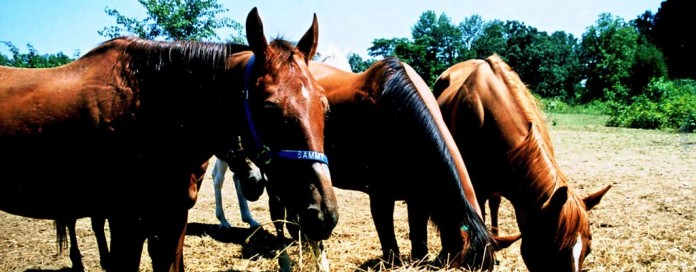URBANA, Ill. — Do dust, pollen and hay trigger your hay fever?
Imagine living where straw and hay are tossed around every day, and it won’t surprise you to learn that horses, too, can get breathing problems from particles in the air. Dr. Kara Lascola, an equine internal medicine specialist at the University of Illinois Veterinary Teaching Hospital in Urbana, spoke recently to horse owners about equine respiratory problems linked to air quality in barns.
Contributing factors
Hay storage areas and dry bedding materials in stalls contribute dust and particles in the air. The methods used for mucking stalls and cleaning the barn can also reduce or increase airborne particles, according to Dr. Lascola.
“If their bedding is very dry and dusty, or if their stall is located below the door to the hayloft, horses will be at a higher risk of developing respiratory problems, or their existing problems may get worse,” said Dr. Lascola.
Dust and debris are kicked up when workers use leaf blowers to clean the aisles and muck stalls with dry bedding while the horses are in, which often happens in barns where every horse does not get turned out.
Respiratory problems
So how do owners know whether a horse is developing a respiratory condition linked to air quality in the barn? And how do they rule out conditions like pneumonia that are caused by more severe diseases?
The two major respiratory conditions that are usually linked to air quality are heaves and inflammatory airway disease, or IAD. These diseases are not accompanied by fever and a productive cough, so those signs indicate a problem beyond an air quality issue.
“Heaves, which is similar to asthma in people, generally affects older horses, while IAD can be seen in younger horses,” said Dr. Lascola.
Horses with heaves will also show signs at rest, such as nasal flaring and labored breathing. Like asthma, heaves can be seasonally recurrent, whereas horses with IAD usually cough only while exercising.
Recovery time
Horses with IAD also usually have longer recovery times after exercise and can seem winded.
“At present, there aren’t good studies associating specific breeds with each of these conditions,” said Lascola, “but we tend to pick up IAD in young racehorses because they are being exercised so much and conditioned so carefully.”
Diagnostic tests for heaves and IAD can be done either in a hospital or on the farm. A “bronchoalveolar lavage” is a procedure in which a thin tube is passed into the horse’s lungs to collect a fluid sample containing lung cells for analysis.
This procedure can be performed on the farm within a couple of hours. Other diagnostics, such as imaging of the lungs and pulmonary function testing, need to be performed in a hospital, but are fairly short procedures as well.
Pulmonary function tests are used to monitor the condition of horses that have already been diagnosed with conditions such as heaves and IAD. In general, the same environmental changes are recommended to address both heaves and IAD.
Improving air quality
“Cutting down on dust in the air or turning horses out while cleaning the barn can make a huge difference for horses with respiratory conditions,” said Lascola.
She also recommends soaking hay to make it less dry and dusty. For horses in the Midwest, she suggests keeping them indoors during the most active periods of harvesting, especially if the pastures are close to farms and the horses’ respiratory signs worsen during these times.
Making improvements
Things as simple as the construction and layout of the barn itself can change air quality dramatically.
“Everything from the positioning of the doors and windows, which can create drafts or impede them, to the location of the hayloft doors in relation to a particular horse’s stall can affect the quality of air a horse breathes,” she said.
When the horse is kept at a boarding facility, implementing environmental changes requires cooperation of the staff there. It is important to make sure that changes owners and veterinarians have requested are actually implemented by all barn hands and workers on the property.
Work with your veterinarian
“The most important aspect of monitoring and controlling air quality is working with the horse’s primary veterinarian and the owners as a team,” Lascola said. “We always want to try environmental modifications before we jump to drug treatments, because often horses with heaves and IAD can be managed by just changing their surroundings which is both less expensive and less time consuming for the owner.”











I think that these are important to everyone who have horses like me. Thanks for the post.